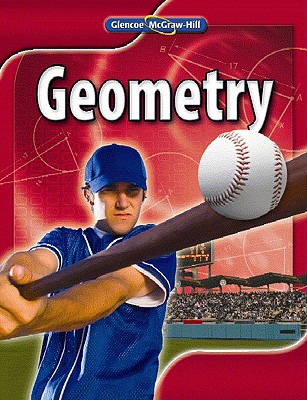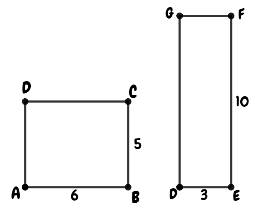
Concept explainers
(a)
To Write: The conditional statement that shows the relationship between the areas of a pair of congruent
(a)
Answer to Problem 33PPS
If triangles are congruent, then they have the same area.
Explanation of Solution
Given information: The given statement is “the areas of congruent triangles are equal”.
As we know that congruent triangles have the same sides and equal three
Therefore, the two triangles will have the same area.
Hence, the conditional statement is ‘If triangles are congruent, then they have the same area’.
(b)
To explain: Whether the converse of conditional statement is true or false.
(b)
Answer to Problem 33PPS
The converse condition of conditional statement is false.
Explanation of Solution
Given information: If triangles are congruent, then they have the same area.
The converse of the conditional statement ‘If triangles are congruent, then they have the same area’ is ‘the triangles have the same area when they are congruent’.
We can see that these are false because two triangles can have the same area but can’t be congruent, depicted below.

Area of the first triangle,
Area of the second triangle,
Thus,
(c)
To explain: The possibility of two equilateral triangles can have the same area but are not congruent.
(c)
Answer to Problem 33PPS
It is impossible to have two non congruent equilateral triangles with the same areas.
Explanation of Solution
Given information: Two equilateral triangles are given.
Two non congruent triangles can’t have the same area because their side’s length and angles not equal.
(d)
To explain: The possibility of two rectangles can have the same area but are not congruent.
(d)
Answer to Problem 33PPS
Yes! It is possible to have two non congruent rectangles with the same area.
Explanation of Solution
Given information: Two non congruent rectangles are given.
Two non congruent triangles can have the same area.

But, we can see from the sketch that sides are not congruent.
Therefore,
(e)
To explain: The possibility of two squares can have the same area but are not congruent.
(e)
Answer to Problem 33PPS
No! It is not possible to have two non congruent squares with the same area.
Explanation of Solution
Given information: Two non congruent squares are given.
Two non congruent squares can’t have the same area.
As we know,
Where, s is side of square.
If the sides of the squares are equal, then its area will be equal. In this condition, its sides also become congruent.
Hence, it is not possible to draw two non congruent squares with the same area.
(f)
To find: The
(f)
Answer to Problem 33PPS
The given conditional statement is valid for regular polygons.
Explanation of Solution
Given information: The conditional statement is given, If a pair of ……. Are congruent, then they have the same area.
The given condition will be true only for equilateral triangle, squares and shapes that have all sides of the same length.
Therefore, we can say that it is valid for regular polygon.
Chapter 4 Solutions
Geometry, Student Edition
Additional Math Textbook Solutions
A First Course in Probability (10th Edition)
A Problem Solving Approach To Mathematics For Elementary School Teachers (13th Edition)
Algebra and Trigonometry (6th Edition)
University Calculus: Early Transcendentals (4th Edition)
Elementary Statistics: Picturing the World (7th Edition)
- find the value of each variablearrow_forwardName: Date: Bell: Unit 11: Volume & Surface Area Homework 2: Area of Sectors Directions: Find the area of each shaded sector. Round to the hundredths place. 1. GH 11 in 2. KL 20 ft H F 64 G L 119 M K 3. BA 6.5 cm 4. YZ 14.2 m B 23 X 87° Y Z 5. KL = 27.1 mm J 32 L X:360-32.1 K A-3 360 7. BD 18 cm E 136 B X=32.8 127.0 (271) A: 069.13 Amm² 19=2102.13 A-136 360.16912 A:300cm² A=96.13 6. PQ = 2.8 in P R 311° 8. WZ 5.3 km V = Z 108 W D 9. HK = 25 ft G H KO 26 X 10. SR 26 m = S 73 T R Gina Wilson (All Things Algebarrow_forward538 Chapter 13 12. Given: Points E(-4, 1), F(2, 3), G(4, 9), and H(-2, 7) a. Show that EFGH is a rhombus. b. Use slopes to verify that the diagonals are perpendicular. 13. Given: Points R(-4, 5), S(-1, 9), T(7, 3) and U(4, -1) a. Show that RSTU is a rectangle. b. Use the distance formula to verify that the diagonals are congruent. 14. Given: Points N(-1, -5), O(0, 0), P(3, 2), and 2(8, 1) a. Show that NOPQ is an isosceles trapezoid. b. Show that the diagonals are congruent. Decide what special type of quadrilateral HIJK is. Then prove that your answer is correct. 15. H(0, 0) 16. H(0, 1) 17. H(7, 5) 18. H(-3, -3) I(5, 0) I(2,-3) 1(8, 3) I(-5, -6) J(7, 9) K(1, 9) J(-2, -1) K(-4, 3) J(0, -1) K(-1, 1) J(4, -5) K(6,-2) 19. Point N(3, - 4) lies on the circle x² + y² = 25. What is the slope of the (Hint: Recall Theorem 9-1.) - line that is tangent to the circle at N? 20. Point P(6, 7) lies on the circle (x + 2)² + (y − 1)² = 100. What is the slope of the line that is tangent to the circle at…arrow_forward
- Can you cut the 12 glass triangles from a sheet of glass that is 4 feet by 8 feet? If so, how can it be done?arrow_forwardCan you cut 12 glass triangles from a sheet of glass that is 4 feet by 8 feet? If so, draw a diagram of how it can be done.arrow_forwardIn triangle with sides of lengths a, b and c the angle a lays opposite to a. Prove the following inequality sin a 2√bc C α b a Warrow_forward
- Find the values of x, y, and z. Round to the nearest tenth, if necessary. 8, 23arrow_forward11 In the Pharlemina's Favorite quilt pattern below, vega-pxe-frame describe a motion that will take part (a) green to part (b) blue. Part (a) Part (b)arrow_forward5. 156 m/WXY = 59° 63 E 7. B E 101 C mFE = 6. 68° 8. C 17arrow_forward
- 1/6/25, 3:55 PM Question: 14 Similar right triangles EFG and HIJ are shown. re of 120 √65 adjacent E hypotenuse adjaca H hypotenuse Item Bank | DnA Er:nollesup .es/prist Sisupe ed 12um jerit out i al F 4 G I oppe J 18009 90 ODPO ysma brs & eaus ps sd jon yem What is the value of tan J? ed on yem O broppo 4 ○ A. √65 Qx oppoEF Adj art saused taupe ed for yem 4 ○ B. √65 29 asipnisht riod 916 zelprisht rad √65 4 O ○ C. 4 √65 O D. VIS 9 OD elimiz 916 aelonsider saused supsarrow_forwardFind all anglesarrow_forwardFind U V . 10 U V T 64° Write your answer as an integer or as a decimal rounded to the nearest tenth. U V = Entregararrow_forward
 Elementary Geometry For College Students, 7eGeometryISBN:9781337614085Author:Alexander, Daniel C.; Koeberlein, Geralyn M.Publisher:Cengage,
Elementary Geometry For College Students, 7eGeometryISBN:9781337614085Author:Alexander, Daniel C.; Koeberlein, Geralyn M.Publisher:Cengage, Elementary Geometry for College StudentsGeometryISBN:9781285195698Author:Daniel C. Alexander, Geralyn M. KoeberleinPublisher:Cengage Learning
Elementary Geometry for College StudentsGeometryISBN:9781285195698Author:Daniel C. Alexander, Geralyn M. KoeberleinPublisher:Cengage Learning

